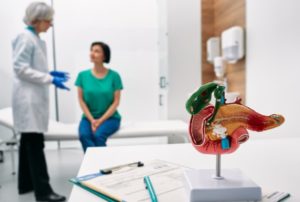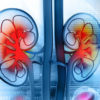 Gallbladder Disease Treatment in Northern New Jersey
Gallbladder Disease Treatment in Northern New Jersey
The gallbladder is a small, pear-shaped organ located below the liver that helps break down food by storing bile and moving it through the bile ducts into the small intestine. At Bergen Medical Associates in northern New Jersey, the gastroenterology team works to identify the underlying causes of gallbladder issues and provide personalized treatment.
What Is Gallbladder Disease?
Any infection or blockage in the gallbladder or the bile ducts can lead to gallbladder disease. The bile ducts are narrow canals that connect the gallbladder, liver, pancreas, and small intestine. Many gallbladder conditions develop as a result of gallstones.
There are several types of gallbladder disease, including:
Cholecystitis
Inflammation of the gallbladder, known as acute cholecystitis, is caused by an obstruction such as gallstones or an infection. The primary symptom usually is a sharp, persistent pain in the upper right abdomen. Other symptoms can include nausea, fever, and vomiting.
Gallstones
Gallstones are tiny, hard deposits of cholesterol or bilirubin that develop inside the gallbladder. Most patients with gallstones don’t have any symptoms. However, large stones can cause biliary colic, an aching pain under the rib cage that comes and goes.
Chronic Acalculous Gallbladder Disease
Also known as biliary dyskinesia, this condition develops when the body can’t move bile into the bile ducts, causing it to back up in the gallbladder. This results in abdominal pain, bloating, and nausea. If left untreated, it can lead to weight loss or irritable bowel syndrome (IBS).
Gangrene and Abscesses
If left untreated, cholecystitis can lead to the death of gallbladder tissue, known as gangrene. Dead tissue may burst or tear, creating abscesses. These need to be treated right away as they can affect other organs. Symptoms can include pain, fever, and nausea.
Congenital Defects
Some abnormalities in the gallbladder or bile ducts are present at birth. These congenital defects can include cysts that block the movement of bile, or structural defects such as malformed ducts. Symptoms of congenital gallbladder defects can include jaundice, discolored stools or urine, or abdominal pain. These abnormalities often can be treated with endoscopic procedures to reconstruct or bypass defective bile ducts.
What Are the Risk Factors for Gallbladder Disease?
Patients with gallstones are most likely to develop gallbladder disease. Risk factors for gallstones include:
- Age: Gallstones are more common in patients over the age of 60.
- Diet: A high-cholesterol diet can increase the risk of gallstones.
- Ethnicity: Patients of Native American or Mexican descent have higher rates of gallstones.
- Obesity: Patients with a high body mass index (BMI) may overproduce cholesterol, which can lead to gallstones.
- Other medical conditions: Patients with diabetes, Crohn’s disease, and cirrhosis of the liver are more at risk of developing gallstones.
- Sex: Women are more likely than men to have gallstones.
There may be a link between gallstones and the modern Western diet, which is high in fat and cholesterol and low in fiber. High-risk patients can improve gallbladder health by eating a balanced diet and maintaining an active lifestyle.
What Tests Are Used to Diagnose Gallbladder Disease?
To diagnose gallstones or related conditions, a provider will review a patient’s medical history and current symptoms. They will examine the abdominal area to check for inflammation and perform tests, which may include:
- Blood work to test liver and pancreas function and check for signs of inflammation
- Ultrasound imaging to look for blockages or growths in the gallbladder
- An Endoscopic Retrograde Cholangiopancreatography (ERCP) test, which uses fluoroscopy to generate X-ray images of the bile ducts
Additional tests such as an endoscopic ultrasound or a hepatobiliary iminodiacetic acid (HIDA) scan may be required to narrow down a diagnosis.
How Is Gallbladder Disease Treated?
If a patient has occasional episodes of biliary colic, they may be able to manage symptoms with pain medication. However, more persistent issues will need to be treated with surgery. Because a patient can have healthy digestive function without a gallbladder, cholecystectomy or gallbladder removal is a common treatment method.
Gallbladder removal often can be performed as a minimally invasive laparoscopic procedure. If a patient has gallbladder cancer or other complications, they may need open surgery, which requires a larger incision.
Choose Bergen Medical Associates
As a patient-centered medical home (PCMH), Bergen Medical Associates offers a wide range of specialties, such as interventional pain management, in addition to primary care. Serving patients throughout northern New Jersey, patients can see an experienced, board-certified gastroenterologist who can diagnose and treat gallbladder disease and other digestive issues, such as acid reflux and inflammatory bowel disease. To learn more, request an appointment today.










